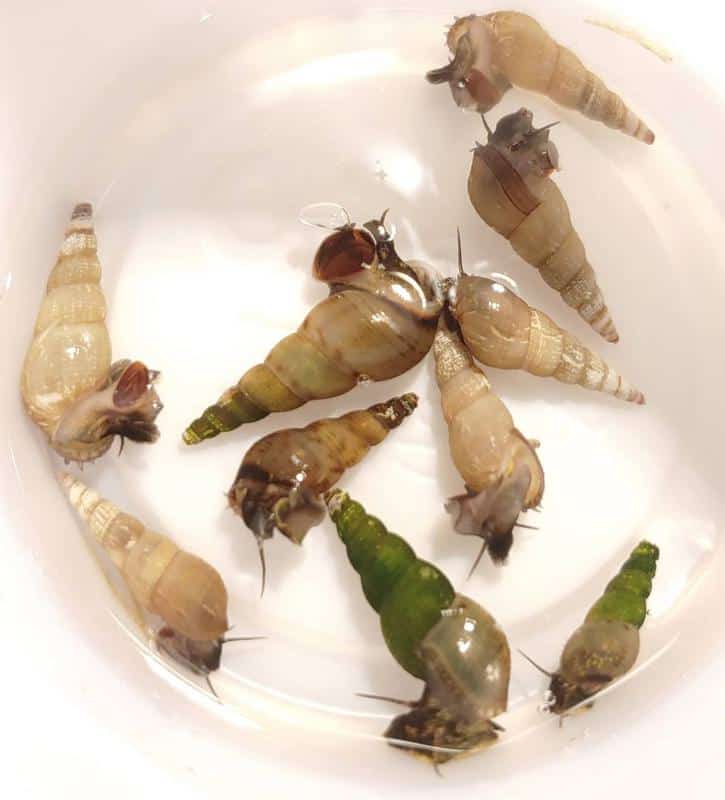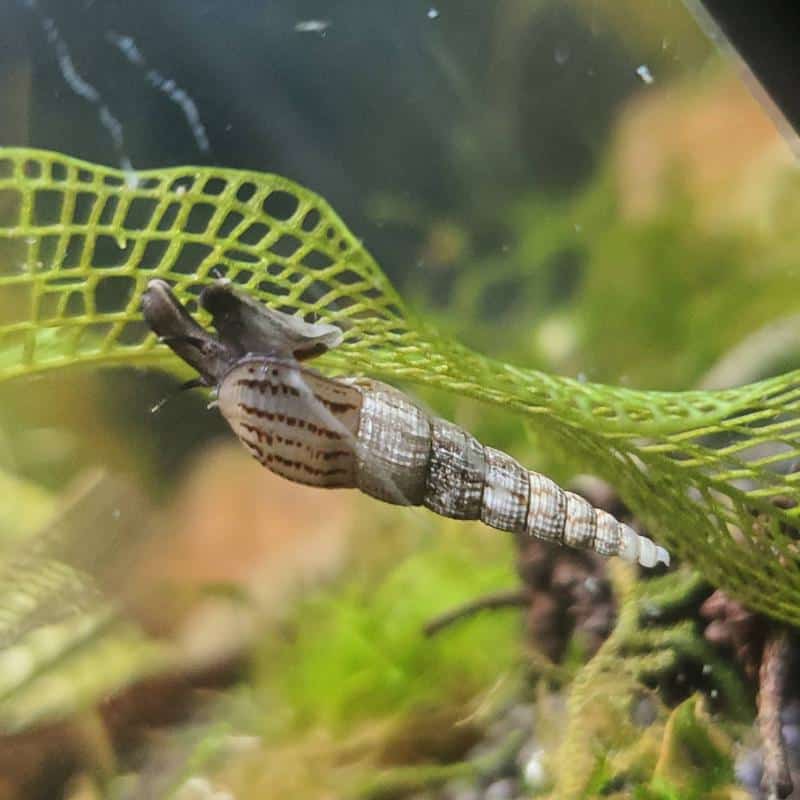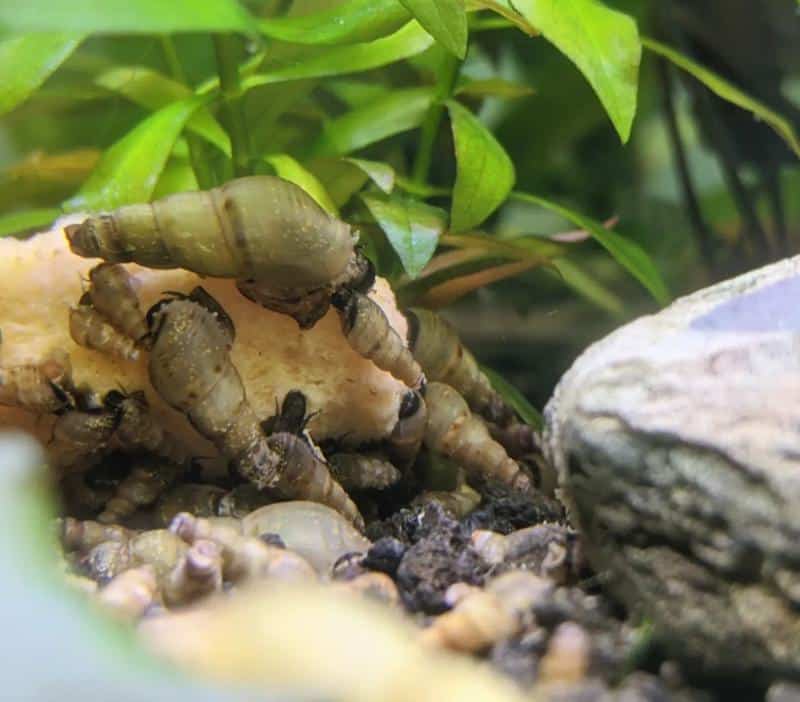Are Malaysian trumpet snails good? The answer is no; Malaysian trumpet snails are an invasive infestation in your aquarium. Only some hobbyists choose to get these snails as pets.
In most cases, trumpet snails are bought as food for other aquatic animals or for profitable farming purposes.

However, that does not mean Malaysian trumpet snails do not have their benefits. These snails are ferocious eaters that feed on algae and plant detritus. They also love eating decaying matter, and their rapid breeding rate can help you get rid of dirt in a short period.
Read on to learn how you can use the unique properties of the Malaysian trumpet snail to your advantage. Get to know how to deal with a trumpet snail infestation and how to care for them as you breed them for sale.
Malaysian Trumpet Snail Overview
Short Summary of Malaysian Trumpet Snails and their habitats
| Names | Malaysian Trumpet Snail (Melanoides tuberculata)
Also known as Red-rimmed Melania Snail, Malaysian live-bearing snails, trumpet snails, Malaysian burrowing snails, Malaysian sails, or trumpets. |
| Origins and Reginal Distribution | Originated natively from Northern Africa and Southern Asia.
Common in many parts of the world from North America to Europe, Arctic Zones and the North Temperate |
| Water Hardness Conditions | 6 – 15 kH |
| Lighting Conditions | Moderate with no direct bright sunlight |
| Average Size | 1 inch |
| Colors | Wide range of colors including grey, white, cream, and brown |
| Lifespan | 1 – 2 years |
| Food | Algae, dead leaves, fish food leftovers, and small leafy vegetation |
| Breeding | Freshwater conditions with 12 degrees of hardness |
| Optimal pH levels | 7.0 – 8.0 |
| Optimal Temperature | 68 – 84 degrees Fahrenheit |
Lifespan
Malaysian trumpet snails live for about one year before they die of old age. Trumpets rarely go past one year despite their resilient nature.
However, it is possible to have the most ideal conditions that can push the trumpet snail’s lifespan to a maximum of two and a half years.
Appearance: Shape, Colors & Size

So, how big does a Malaysian trumpet snail get?
Trumpets rarely grow larger than one inch. However, they can reach 2 inches maximum in nature if they are surrounded by the ideal conditions. Typical sizes range from 0.25 inches to 0.5 inches, and if you find any stock bigger, then you know they are stronger and well-fed under the best conditions.
Also, longer trumpet snails tend to be female rather than male, but like most snails, telling the difference between the genders is practically impossible.
Trumpets are also distinct because of their cone-like shell featuring a rough texture formed by rings that surround the shell from the apex to the other end. There are many color varieties out there, but the most common shell colors include grey, cream, brown, and white.
The only protective system trumpet snails have is their tentacles featuring black dotted eyes and the operculum placed right at the shell’s opening. The purpose of the operculum is to shield the delicate insides of the shell from predators.
Malaysian Trumpet Snail Behaviors
Trumpet snails eat at an astronomical rate. The deposited food in the substrate, décor, and aquarium bottom are their best feeding places.
The trumpet snails’ most distinct trait is burrowing through the substrate while scavenging for food. They prefer to remain hidden under the sandy substrate during the day, constantly scavenging for food.
Even though they are nocturnal, trumpets choose to do most of their feeding during the day. They only take advantage of the night to rise out of the sandy substrate and see what they can find at a higher water surface.
Did you know: Some fishkeepers view Malaysian trumpet snails as beneficial scavengers as their burrowing behavior in the substrate helps aerate the sediment.
Breeding
So, how fast do Malaysian trumpet snails breed?
Well, one female trumpet can give birth to more than 70 young juveniles at a time. This is hundreds of times faster than the Assassin snail and a bit faster than the bladder snails, which give rise to about 40 young juveniles at a go.
Trumpet snails are not hermaphrodites despite their rapid breeding rate; they are livebearers (they do not lay eggs) that can conceive sexually or through a process known as parthenogenesis. Parthenogenesis is a process where a female egg can grow into an embryo without the need for male fertilization.
Their unique reproductive process is what causes them to be a pest infestation risk. Since they do not have to wait for an incubation period for eggs to hatch, nor do they have to wait for a male to fertilize the eggs. For these reasons, trumpets can easily overrun your tank in a matter of weeks.
Very few snails can reproduce at the astronomical rate of Malaysian trumpet snails. Ramshorn snails and pond snails are the only worthy contenders, but they are limited by their egg incubation period.
Please keep in mind that the abundance of food increases the breeding rate exponentially. This means that if you want them to reproduce faster, you have to add more food into the breeding tank. However, you can opt to reduce the amount of food they have access to reduce their numbers.
Malaysian Trumpet Snail Care

The trumpet snail species is a hardy and resilient kind. These snails can withstand harsh and demanding environments due to their highly adaptable bodies. This is a good thing for those planning to farm them, but terrible news for hobbyists who are dealing with a trumpet snail pest infestation.
Here are a few considerations that will help you extend the usefulness and lifespan of your trumpet snails:
Tank Size & Aquarium Environment
The substrate at the bottom of your fish tank is the only major condition that needs your uttermost attention. Trumpets are burrowers; they evolved to have pointed shells that give them the ability to dive into the sand and scavenge for food.
A rocky substrate or small sandy substrate will significantly impact the life and success of your trumpet snails. They spend most of their time at the bottom, and their food source is limited when they can’t dive into the sand to hunt.
Rarely will you find a trumpet snail looking for food at higher water levels when there is a sandy substrate filled with algae, dead vegetation, and fish food leftovers.
In fact, most Malaysian trumpet fish die in the substrate and never surface, never to be seen. If you have done an extermination and are wondering where the dead snails are, then the sandy substrate is a good place to start.
However, it is a good idea to leave the dead trumpets at the bottom. They act as nutrients to the growing plants and will limit the hours you may have to put in to get them out of the tank manually.
Smaller tanks can suffice when it comes to their ideal tank size. As small as 5 gallons of water per handful of trumpets is okay. The most optimal setup is a 10-gallon tank and over.
Please always remember that a bigger tank is always better since the population will increase over time and so will the bio-waste from the snails.
Because of their small sizes, it is important to be mindful of hazards, particularly filter intakes that can trap the trumpets. This is where sponge filters come in handy.
Consider reducing the power of the filter intakes too because larger currents can draw the snails closer to the tiny entrapments of the filters.
What about tank mates? The only bad tank mates to Malaysian trumpet snails include snail-eating fish and the Assassin snail. Other than that, trumpet snails peacefully coexist with many species, from other freshwater snails to filter-feeding shrimps like the Vampire shrimp and freshwater clams.
Typical compatible animals that you will find alongside Malaysian trumpet snails include Cory Catfish, Otocinclus Catfish, freshwater clams, cherry shrimp, Ivory snails, mystery snails, and nerites.
Water Quality & Water Parameters
Little effort is needed to create the best water conditions for trumpet snails. Trumpets can thrive in brackish waters and a wide range of water hardness. These snails are very resilient to harsh conditions, but bladder snails seem to be tougher in comparison.
Avoid copper-infested waters to keep the water quality high. Copper is often introduced from tap water and is very dangerous to snails. A small copper contamination can wipe out an entire flock of trumpets.
Other things to eliminate include Ammonia and nitrate levels. Ammonia and nitrate can also get very high because of overstocking the Malaysian trumpet snails. You will often face this problem when you have an infestation.
This is a good sign to downsize by either transferring the trumpets to another tank or disposing of them.
A water testing kit will come in handy in this particular case. Ensuring the conditions are stable will do a better job of keeping your trumpets alive.
Always aim for stable water parameters rather than perfect conditions. Snails, similar to fish, are more at risk of shock and stress when parameters keep shifting rather than when the parameters are not at their most ideal level.
Keep the water parameters between these conditions to have a thriving trumpet snail stock:
- Water Hardness: 6 – 15 kH
- Ammonia, nitrate, nitrite levels: 0 PPM
- pH Levels:0 – 8.0
- Water Temperature: 68 – 84 degrees Fahrenheit
Malaysian Trumpet Snail Diet

Calcium-rich diet is the most important for trumpets since it helps create harder shells. Good calcium-rich foods for trumpets include sliced vegetables, peas, soybeans, basil, and strawberry.
Only supplement their natural diet in the tank when necessary. Supplement meals include sliced vegetables and commercial mineral blocks full of calcium.
As much as they feed on soft algae, the Malaysian trumpet snails also prefer fish food leftovers and other forms of edible debris.
The good news is that these rapidly populating snails do not eat live plants. They only wait for dead plant material and decaying matter from the plants to have their fill.
If you see them nibbling on your plants, do not worry, they are just eating dead material off them and any fish food leftovers floating around the plant.
How to Get Rid of Malaysian Trumpet Snails
Quarantine is the first step you should take when introducing new live plants into the aquarium. Trumpets are tiny hitchhikers that cling onto water plants, and if the plant came from infested waters, then you can be assured they will be introduced to your tank if you do not quarantine the plants.
Please note that Malaysian trumpet snails carry parasitic lungworms, which can be transmitted to humans. A good practice to avoid getting the potentially fatal parasite is always using gloves and avoiding catching the snails with your bare hands.
Get rid of Malaysian trumpet snails by introducing Assassin snails into the tank. Assassin snails feed on other snails and are very effective at exterminating snail pest infestations.
The Malaysian trumpet snails are the Assassins’ main source of food in the wild, and you will be happy to see how fast the Assassins feed on the tiny creatures.
Another effective solution is to keep snail-eating fish like the Yoyo loaches or Goldfish.
Read More:
Final Thoughts
Apart from cleaning your tank by feeding on decaying matter and algae, trumpet snails act as substrate aeration agents. Their behavior of digging into the substrate promotes aeration that improves plant growth and reduces risks of water toxicity.
Therefore, looking at your frustrating Malaysian trumpet snail infestation as a blessing in disguise can be beneficial. This is your chance to improve the life of your other aquatic life by caring for the trumpet snails.